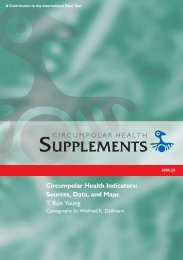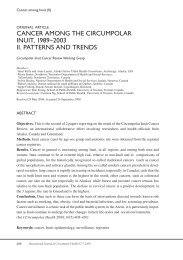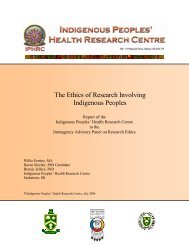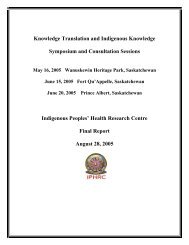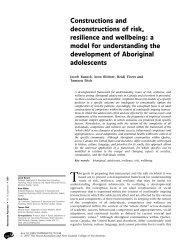EVALUATION OF THE ONTARIO COMMON ASSESSMENT ... - CCIM
EVALUATION OF THE ONTARIO COMMON ASSESSMENT ... - CCIM
EVALUATION OF THE ONTARIO COMMON ASSESSMENT ... - CCIM
Create successful ePaper yourself
Turn your PDF publications into a flip-book with our unique Google optimized e-Paper software.
OCAN Evaluation for Aboriginal Mental Health Programs<br />
Fit of OCAN with Aboriginal Culture<br />
Workers challenged the notion that OCAN is a valid and reliable tool in indigenous populations. The OCAN<br />
has a clearly “Western and clinical feel” and workers feel they have to “sell somebody else’s culture when<br />
they implement OCAN” with their Aboriginal clients. One workers stated: “If it was designed to truly fit the<br />
Aboriginal communities then it would work, but if you take a Western tool and implement it in First Nations<br />
then you have missed the boat, and are implementing a tool that does not fit”.<br />
Workers were in agreement that OCAN would need some adjustment to fit with Aboriginal clients and their<br />
worldview. Workers suggested that OCAN could be adapted to the Aboriginal concept of the medicine<br />
wheel, to show clients how the wheel might be off balance when certain aspects are lacking. This approach<br />
would also support the visual learning orientation of many Aboriginal clients, and allow them to see where a<br />
healthy balance is lacking in their lives.<br />
Some workers felt that the idea of asking clients to rate the many domains of information upon intake is not<br />
compatible with clients’ culture, particularly since the questions are seen as intrusive. “It is a foreign idea.”<br />
Further, the OCAN as an “assessment tool” seems to resonate negatively with clients who view this as a means<br />
only of describing in almost clinical fashion a listing of deficits. Some suggested that clients might be more<br />
receptive to participate if the OCAN was described or depicted as a “personal wellness inventory” and the<br />
domains structured around the “medicine wheel” concept. A medicine wheel, which is also broad and holistic<br />
would be more accepted, because the approach is more familiar.<br />
Overall though workers did appreciate the broad spectrum of information collected with OCAN and believed<br />
that it has the potential to capture aspects that might otherwise be overlooked.<br />
Two questions were seen as particularly problematic: (1) the question on sexual expression and (2) the<br />
question on psychotic symptoms. The question on sexuality is often too intrusive for Aboriginal clients, although<br />
it might be significant. The worker needs to be skilled and know when and how to approach this subject. The<br />
question on psychotic symptoms needs to be carefully explored within the context of Aboriginal culture.<br />
Aboriginal spirituality can be expressed or experienced through visions or voices, and great care must be<br />
taken not to confuse this with psychotic symptoms.<br />
Some workers felt that all references to immigration status should be removed for use with indigenous<br />
populations.<br />
Sutherland & Maar - March 2010 Page 33



